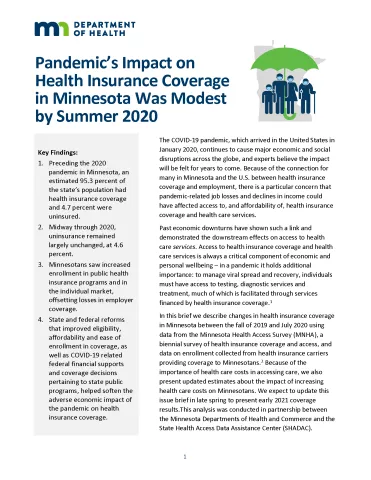A new report released by the Minnesota Department of Health (MDH) shows that Minnesota’s uninsured rate for the first half of 2020—as well as the first known period of the coronavirus pandemic—was relatively unchanged from the fall of 2019, at 4.6% and 4.7%, respectively. The report uses data from the biennial Minnesota Health Access Survey (MNHA), conducted collaboratively between the Minnesota Department of Health (MDH) and the State Health Access Data Assistance Center (SHADAC), to examine changes in health insurance coverage across the state from 2017 to 2019, as well as preliminary coverage estimates from 2020 to measure changes to the insurance landscapr from fall 2019 to spring and summer of 2020.
Pre-Pandemic Coverage Conditions
Prior to the COVID-19 pandemic, the state of Minnesota was enjoying historic levels of health insurance coverage among the overall population. From 2017, the last time the MNHA Survey was conducted, statewide coverage grew significantly to 95.3% in 2019, propelled by gains in employer-sponsored insurance coverage (51.9% in 2017 to 53.6% in 2019), relatively unchanging numbers of public health insurance coverage enrollment, and stabilization of the individual market.
Impacts on Health Insurance Coverage, 2019 to 2020
Using data from the 2019 Minnesota Health Access Survey and the 2020 Health Insurance Enrollment Survey, the report looks at the changes wrought by the COVID-19 pandemic on the insurance coverage landscape from October 2019 to April 2020 and October 2019 to July 2020.
From October 2019…
- …the number of uninsured individuals increased by 600 people in April 2020 and 5,800 people in July 2020.
- …enrollment in public coverage increased by 16,000 individuals in April 2020 and 60,500 individuals in July 2020.
- …enrollment in private insurance fell for both group (i.e., employer-sponsored) coverage—14,400 by April 2020 and 40,100 by July 2020—and individual coverage—15,600 by April 2020 and 13,000 by July 2020.
Health Insurance Coverage Costs, 2017 to 2019
Regardless of the pandemic, a frequently cited issue among Minnesotans with health insurance coverage was the high cost of care, which led to issues of both foregone care as well as reports of trouble paying medical bills, or trouble paying other basic bills (food, housing, etc.) due to high medical bills.
Estimates from the MNHA survey revealed that:
- 25.0% of Minnesotans overall reported having to forgo needed health care due to cost (up from 21.1% in 2017)
- 27.1% of Minnesotans with public insurance reported having to forgo needed health care due to cost (up from 23.7% in 2017)
- 21.0% of Minnesotans with group coverage reported having to forgo needed health care due to cost (up from 16.5% in 2017)
Estimates from the MNHA survey revealed that when it came to experiencing financial burden due to medical bills:
- 22.0% of Minnesotans overall reported experiencing high medical burden (up from 19.8% in 2017)
- 22.5% of Minnesotans with group coverage reported experiencing high medical burden (up from 19.9% in 2017)
Read the full brief detailing these findings, from SHADAC and the Minnesota Department of Health’s Health Economics Program.

